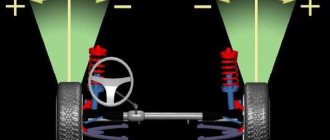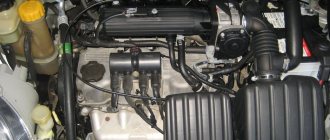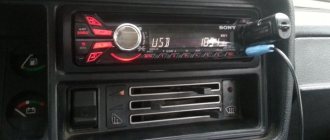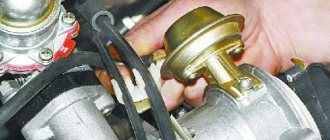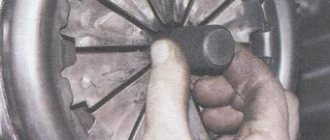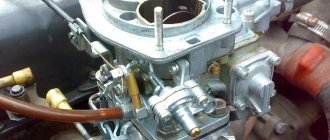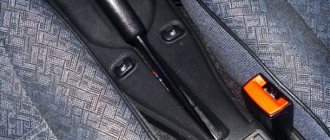For every driver, the issue of high-quality and proper operation of the car is always in the first place. When it comes to steering and its performance, you need to be especially careful and careful. Steering is one of the most important parts of any car. If the car pulls to the left, the causes of the problem must be urgently identified and eliminated. This can save you from unforeseen situations. Let's look at why a car leaves a straight course.
It should be noted that the reasons for the car pulling to the side can be practically nearby and you won’t have to look for them for a long time. But it also happens differently.
Why does the car go off course?
There are several typical faults that can cause the car to pull to the right or to the left.
And the roads, or rather their condition, are not always to blame. The most popular reasons are:
- wheel alignment;
- tire pressure;
- play in the steering;
- condition of the rubber.
Below we will look at everything in more detail.
Faulty brakes
It happens that the car deviates slightly from a straight path while braking. In this case, the reason lies in the failure of the caliper hydraulics on one of the wheels. The problem may be hidden in a system that has lost its tightness, in torn seals and brake fluid leaks. In this case, the slip increases with increasing deceleration intensity. In this case, it is urgent to park in a safe place and check the system. If fluid drips from the caliper, the car requires urgent repairs. You can no longer drive it, and to get to the service, you need to call a tow truck.
Rear wheel offset
If the rear wheels are offset relative to the car body, this will also lead to a situation where the steering wheel pulls to the left when driving. This often happens after poor or incorrect wheel alignment settings. What to do in this situation? Experts recommend re-adjusting the camber and toe. It is worth noting that the rear wheels are not adjustable on all cars.
You should also diagnose and, if necessary, adjust the position of the front wheels relative to the rear. If there are geometry violations, then after eliminating the problem the car will drive correctly.
Side wind
Sudden gusts of wind also affect directional stability. The higher the car body, the greater its windage, that is, the area over which air flows exert lateral pressure. Therefore, the effect is best seen in lifted SUVs with rear multi-link suspension and in vans. When there are sharp gusts of wind, the body tilts and causes steering. Due to good sound insulation, drivers do not always recognize side winds and are afraid of a sudden change in the car’s trajectory. The wind is determined by the swaying branches of trees, as well as by the smooth vibrations of the body. In some dangerous places, special striped wind indicators are installed on dams and bridges to warn of changing wind loads. If the gusts are strong, you have to slow down to avoid getting into a dangerous situation.
Sun and tires. What is the best tire pressure to keep in the heat? More details
Tire pressure
If your tires are not inflated evenly, this is another possible reason for your vehicle to pull to the side. It is worth checking the pressure in all wheels. If the car leaves a straight course, then the first thing to do is check the pressure in the wheels on the side where the car goes.
If the difference between the tires is at least 0.5 atmospheres, the car will definitely go off course. To eliminate the cause, it is enough to inflate the wheels so that they have the same level.
Body geometry
After severe accidents, the structure of the body is damaged, the side members become wrinkled, causing the wheel mounting points to become deformed. The geometric location of the hubs is distorted, which is why the car can no longer drive exactly straight. One of the wheels is sure to steer, causing the car to go sideways. It is impossible to repair this malfunction, since it is impossible to straighten the body exactly to factory specifications. It is prohibited to operate such a vehicle and it must be scrapped.
Article on the topic
Don't panic. How to stop a car with faulty brakes?
Tire condition
A common occurrence is various tire defects. So, on cars (including new ones), the tire wears unevenly. Therefore, the steering mechanism is unstable.
Also, during the operation of the car, deformations of the metal frame of the tires are possible when driving on bad roads with low pressure. In this case, there will be no characteristic beating in the steering wheel. But the car’s drift off course appears immediately.
There are also situations when a narrow part of the cord layer in a tire breaks. Most often, such ruptures occur when the car is driven on uneven roads with low tire pressure. The result is the formation of a thin strip opposite the bead of the disk inside or outside the tire.
It is necessary to check the condition of each tire. If there is a serious wheel defect or tire wear, you can solve the problem by replacing the tires. But this does not always work out, since tire prices are quite high, and this is a serious purchase. In this case, experts recommend trying to turn the old tires in the other direction. Then the flat side will be on the outside. The worse one will go inside. This way you can solve the problem of the car moving to the side and save a serious amount. But it is worth noting that some tires have an asymmetric tread. In this case, you can try to re-align and drive until the tread wears off as evenly as possible. Usually this takes from 1 to 2 thousand kilometers.
But naturally, if the wear of the rubber is large, a simple rearrangement will not be enough for a long time, and after a while the situation may repeat itself or the rubber will wear out completely.
Why does the steering wheel pull to the side when braking?
But if the symptom of steering wheel slip appears exclusively during braking, then, most likely, the brake pads are jammed on the brake disc or drum. This is also easy to understand - drive at a normal pace for 10-15 minutes, periodically working the brake pedal - use your brakes, and then stop and check how hot the brake discs are on the front wheels - be careful not to get burned: do not touch the calipers immediately after stops, and first splash a drop of water into them or just spit - if the water (saliva), barely touching the surface, boils (provided that you did not brake for a long time “to the floor”), then this means that the pads are stuck in the caliper while pressed position towards the brake disc. In this case, most likely, such a problem will be observed only on one side of one specific wheel of the car. Also, check the brake pads themselves for uneven wear. But to eliminate this malfunction after identifying it, you will again have to contact a specialist auto mechanic.
Unknown reasons
Unfortunately, even experienced diagnosticians sometimes cannot determine what happened and why the car behaves this way. The fact is that even serious companies allow various minor defects at the car production stage. Some of them can be detected during maintenance, but others cannot be identified. Defects associated with the car pulling to the side can be solved by adjusting the wheel alignment. This procedure costs about 500 rubles. But if the car pulls to the left, and the camber is normal, then what is the reason? We also note that this problem can occur when the suspension arms are bent. The car was in an accident or fell into a large hole at speed.
Brake system malfunction
Complications in the brake system, including a stuck brake caliper, dry sliding pins, and a broken brake hose, can create problems with your vehicle pulling to one side. A stuck caliper is the most common of all issues. The calipers apply pressure to the brake pads, drawing energy from the hydraulic brake system. They are crucial in stopping the car after pressing the brake pedal. The car will pull to the side if one of them is not functioning properly.
How to fix it? A responsive braking system is critical to driving safety. You need to urgently contact a professional mechanic at your nearest car service center.
The car goes away when accelerating
Front-wheel drive cars can move to the side if so-called spacers are installed on the front springs.
In this case, the steering wheel will be pulled in the direction where the drive is longer. The axle shaft operates at a certain angle, and on a longer drive the centrifugal force will be higher. This is why the car pulls to the left when accelerating.
On domestic VAZ cars, the situation when the car goes off course is built into the manufacturing process by default. This can only be influenced by replacing the longitudinal inclination of the shock absorber strut.
Engine torque
The car pulls to the side when engine torque affects the steering. A front wheel drive (FWD) vehicle pulls to the right when accelerating when the steering wheel is turned. There can be several causes: a loose steering element, a faulty lower control arm bushing, a damaged engine mount, a flexible tie rod, or excessive movement in the ball joint.
How to fix it? Since several components may be to blame for this problem, it is better to take the car to a workshop. You may need to install a limited slip differential (LSD), guides, intermediate drive shaft, or repair other components.
Tires and wheel alignment
The car owner changes the tires, then the wheel alignment is adjusted. As a result, the car still leaves, but before installing new tires and adjusting the angles, everything was fine. What's the matter?
The reason is that previously the slip created by the tires was compensated for by incorrect wheel alignment angles. Once adjusted, this balance no longer exists. Hence the problems. This is why the car pulls to the left after changing wheels.
Experts recommend checking how tires affect car steering. To do this, swap the front wheels. If the car starts to move in the other direction along with the tires, then the causes of the malfunction are directly related to them. You can solve the problem by installing one of the front tires in reverse - so that the inner part now becomes outer.
If directional tires are installed, then the wheels are temporarily swapped to make sure that the problem is with the tires. If the car pulls to the left after replacing the wheels, then install the front ones back, and then search for a pair on which the car will go on a straight course. This problem has now become especially common on domestic tires. It's all about the quality of production - you can observe various violations of the rubber frame, which causes deformations.
If the chassis has been diagnosed, but the car pulls to the left, the reasons may lie in the fact that only the front axle of the car has been adjusted. You need to make sure that everything is fine with the rear axle too. But more often it happens differently - there are deformed parts on the rear axle. Sometimes even camber adjustment specialists cannot notice these defects.
Elasticity and rigidity
The changed elasticity of the suspension affects the handling. This happens if you change parts not in pairs, but one at a time. For example, a broken spring is thrown out, and a new one is put in its place, while the same part remains on the other side. The stiffness and elasticity of the springs can change, and on uneven surfaces they react differently to shocks and vibrations. As a result of uneven damping of vibrations, the body provokes microscopic steering of the suspension, which is enough to cause the vehicle to veer to the side.
The elasticity of the suspension is also affected by incorrectly placed cargo. If there are a couple hundred kilograms of building materials in the trunk, lying at one end of the body, and bags of potatoes are placed on the back seat, then difficulties with handling cannot be avoided. The body rolls and causes a distortion of the trajectory.
Why are installation angles disrupted during operation?
Probably every car owner has noticed that over time the car changes its behavior. So, even if the car did not get into an accident, if the owner drove very carefully, then sooner or later the car will begin to move away from straight-line motion.
This happens due to subsidence of elastic parts in the suspension mechanism. These are springs, rubber bands, body parts. Also, over time, gaps appear and accumulate in the hinge joints in the suspension. When these gaps add up, a quite noticeable change in angles is formed.
The angle also changes due to the aging of the car body. He experiences bending and torque. This leads to the fact that the geometry gradually changes, and the wheel alignment angles increase. As a result, the car pulls to the left or right while driving.
Play in steering components
If your car is equipped with a front-wheel drive system that sends power to the front wheels (front-wheel drive), then it is possible that you have a problem with the steering components if the car only pulls to the side when you press the gas pedal.
To understand this, you must perform the following test while driving. Compare the car's handling when driving with the gas pedal pressed and when coasting in the neutral position of the gearbox. For example, if you notice that when you press the gas pedal there is play, knocking, etc. in the steering wheel, but when you release the throttle there is play, etc. disappears, this clearly indicates problems with the steering. It is also quite possible that your car has worn balls or the silent blocks/bushings have failed.
Features of setting the wheel angle
If the camber angle of the car is adjusted correctly, this will provide the car with reliable grip on the road surface, as well as stability during driving. If this parameter is adjusted incorrectly or is not configured at all, then this entails a lot of problems, one of which is a violation of control.
What is collapse? This is the angle between the perpendicular to the road surface and the central plane on the wheel. The parameter is measured in degrees, and the wheel must be straight. If the camber angle is zero, then the wheel will be in a vertical position on the road. With positive camber, the top of the wheel is tilted outward; if the camber is negative, then the wheel is tilted inward.
The most critical wheel alignment angle is considered to be the toe angle. If it is too positive or negative, this entails excessive wear of the rubber. Toe-in is the difference in distances, which are measured at the front and rear points of the wheel rim on a horizontal plane. This value is calculated in millimeters.
If the distances at the front points are less than at the rear points, then the toe-in is positive. If it’s the other way around, then it’s negative. Toe is considered to be zero if the wheels are installed parallel. This is the most correct parameter.
Reason #3. Tire type on one axle
In this case, any discrepancy between the tires on one axle plays a role. For example, one has a new tire installed, and the coaxial one has an old one. It’s even worse if one tire is summer and the other is all-season, or even winter. Different tread patterns, installation on the wrong side, and even different models with the same configuration are very real reasons why a car pulls to the side when driving.
In addition, the problem can occur if a tire is punctured on the road and then a spare wheel is installed. Today, it is very rare for car owners to buy a set of 5 tires, one of which they carry as a spare. More often, some kind of “left” tire acts as a spare tire, which is guaranteed to differ from the main set in terms of tread pattern, model, and even seasonality. Therefore, driving for a long time with a spare tire is not recommended. It is advisable to fix the puncture at the nearest tire shop, and return the “original” tire to its place as soon as possible.
Tire problems
The pressure difference in the front wheel cylinders is the most common reason for a car to easily pull away while driving. Diagnosis could not be easier - just measure the pressure with a pressure gauge and, if necessary, pump up the sagging slope. If the car pulls to the right, then low pressure should be observed in the right wheel and vice versa. Otherwise, you need to look for the problem elsewhere.
Equally common is uneven wear of the rubber on the wheels of the front axle. The reasons for the phenomenon are:
- a car enthusiast rarely monitors tire pressure;
- the wheels have not undergone the balancing procedure;
- in front there are tires with different patterns and sizes;
- slopes with a directional pattern are installed incorrectly;
- long driving with unadjusted camber angles of the front wheels.
Rubber of varying degrees of wear often ends up on one axle as a result of seasonal replacement. The owner of the “iron horse” did not mark the removed wheels according to their installation locations and next time he put them on at random. As a result, the rear and front axle tires got mixed up.
Reference. On front-wheel drive cars, the front slopes wear out much faster than the rear ones. If the wheels are mixed up and placed on one axle, the car will begin to pull towards a lower tread.
How to solve the problem of unevenly worn rubber:
- Choose a tire with high tread instead of a worn wheel. For example, install a spare tire.
- Balance the wheels, check and adjust the camber angles. Continuing operation and waiting for the differential to complete its task will increase the load on a tire of a larger diameter, causing the tread to quickly wear out.
- Place the rear slopes forward.
Avoiding the above-described manipulations is quite simple - pump up the cylinders in a timely manner, carry out balancing at intervals of 5 thousand km and visit the camber stand every 10-15 thousand km or after a strong blow to the suspension.
Pulls during acceleration
There is another situation when the car begins to pull precisely during acceleration. Sometimes this is accompanied by jerking.
Most often this is due to:
- tire pressure;
- wheel alignment;
- tire wear or damage.
Much less often, symptoms appear due to play or malfunction of the steering mechanism.
I think this is where we can say goodbye.
Subscribe, leave comments, ask questions that interest you and invite your friends to join us!
(No ratings yet)
Steering wheel pulls left or right
There may be several reasons why the steering wheel constantly pulls in one direction or another. We will try to analyze all the typical cases, but first we will note the main typical situations when the steering wheel can move away from the neutral position:
Steering gear play . The permissible play of the steering wheel should be within 5 degrees in both directions. If there is excessive free play, the steering wheel may tilt in one direction or another.
Displacement of the rear wheels (axle) relative to the body axis. Violation of body geometry may cause the steering wheel to pull to the right or left. Plus, the problem may arise due to poor-quality wheel alignment. Experts recommend adjusting the front wheels taking into account the displacement of the rear wheels, then such troubles will not occur.
The rear wheel camber is not calibrated . If there is a sufficiently large difference in the camber angles of the rear wheels, the steering wheel pulls to the left or to the right, depending on the specific situation. This is especially true when there is a negative angle on one wheel and a positive angle on the other.
Uneven tire inflation or tire defects are quite often prerequisites for the steering wheel to move away from neutral. The difference in tire pressure should not exceed 0.5 atmospheres. In some cases, problems associated with rubber defects can be eliminated by changing tire locations or rotating the tires on rims.
Unidentified defects in steering or chassis components. Sometimes hidden design or manufacturing defects are quite difficult to detect during maintenance, during repairs and wheel alignment adjustments.
The steering wheel pulls to the side when the camber is not adjusted
The Macpherson suspension is equipped with struts equipped with oval holes, which allow you to loosen the mounting bolts and rotate the knuckles along with the wheels to a certain angle. At the same time, some models of imported cars may not provide wheel alignment adjustment. This situation is typical for Korean cars Kia and Hyundai, as well as Japanese cars Nissan and Mitsubishi, equipped with a suspension whose struts have round holes. As a result, the appropriate adjustment cannot be made. If the steering wheel pulls to the side, the problem can be corrected by boring the holes to allow the bolts to loosen and the knuckles to turn.
Most often, on cars with right-hand drive, the camber angle is made taking into account the slope of the road built for left-hand traffic. To eliminate steering wheel pull, in this case, you will also have to bore the holes in the struts and adjust the wheel alignment for right-hand traffic, as is customary in our country.
When braking, the steering wheel pulls to the side
If the steering wheel pulls to the side when braking a car, you need to check the serviceability of the brake system.
Usually in these cases, the main reason for the steering wheel slip is due to wear or a defect in the braking cylinder on one side or another of the body or air entering the system.
First try bleeding the brake system. If the problem persists, inspect the brake cylinders. When you press the pedal, the cylinder rods should come out evenly. If this does not happen or the rods do not retract, or there is a fluid leak, you will have to replace the failed brake cylinders.
The second reason for a car to pull to the side during braking can be a significant difference in wheel alignment angles. When the values of the pitch and camber angles are quite different, the car will pull to the side when braking. While during acceleration or when moving uniformly, your car can move in a straight line due to the mutual balancing of these parameters.
When accelerating, the steering wheel moves to the side
If on a car with front-wheel drive there are additional washers (spacers) installed on the front springs, as evidenced by the raised front end, the steering wheel may pull in one direction or another, depending on which side the thicker washer is on. In this case, both axle shafts will work at different angles. Due to the inequality of centrifugal forces, the car may be pulled in one direction or another.
On VAZ cars of the 2108, 2109 and 2110 series, the vehicle is already designed to be pulled to the side. However, this can be eliminated by independently adjusting the angles of the racks. You should remove one or two washers from the right side and move them to the left side. On some foreign cars, to prevent the car from pulling to the side, damping counterweights are provided on the axle shafts.
The steering wheel pulls to the side after performing a maneuver
For some car models (for example, Audi 100 and Moskvich 2141), sideways movement may occur after turning. After turning the steering wheel to the left, it pulls to the left all the way, and when turning to the right, the steering wheel goes to the right. This situation is a consequence of the failure of the upper supports. If they jam, the spring begins to knock on the cup, rather than turning with it, as it should be according to the design of this unit. The problem is solved by identifying the damaged element and then replacing it.


